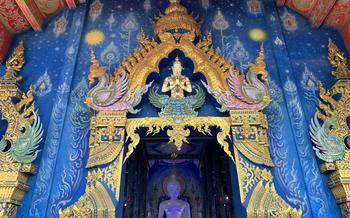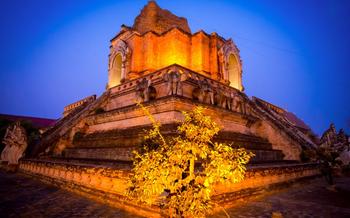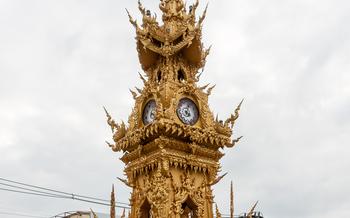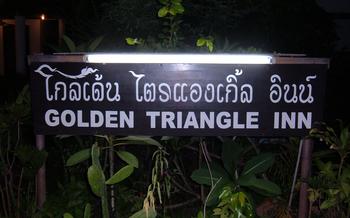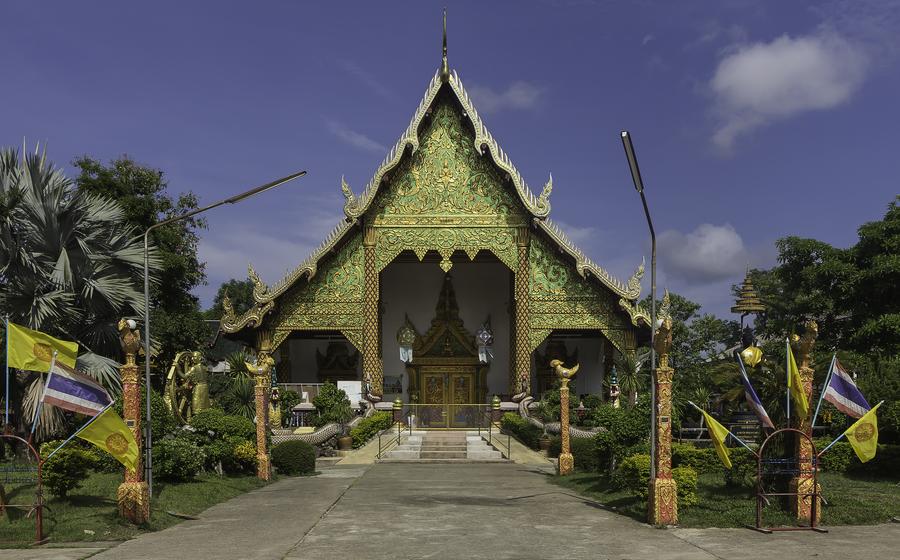
Wat Santikhiri
- Reaching Wat Santikhiri: A Scenic Adventure
- Exploring the Temple Grounds: Serenity and Beauty
- The Grand Staircase: A Journey of Faith
- The Golden Buddha Image: A Symbol of Reverence
- The Bell Tower: A Divine Melody
- The Ubosot: A Sacred Sanctuary
- The Relics of Luang Pu Sim: A Revered Figure
- The Meditation Center: A Path to Inner Peace
- The Viewpoint: A Panoramic Masterpiece
- Lunch Break: A Culinary Delight
- Temple Etiquette and Respect
- Photography Tips for Capturing the Essence
- Insider Tip: Unveiling the Secret Staircase
Reaching Wat Santikhiri: A Scenic Adventure
Transportation Options from Chiang Rai City:
To reach the majestic Wat Santikhiri from Chiang Rai city, immerse yourself in the scenic countryside adventure. Various transportation options await you, catering to different preferences and budgets. Embark on a leisurely drive, enjoying the picturesque landscapes along the way. Alternatively, hop on a local bus or hire a private vehicle with a knowledgeable guide to enhance your journey.
Driving Directions and Parking Availability:
If you choose the self-drive option, follow the scenic route towards Mae Kok. Embrace the winding roads that lead you through lush greenery and quaint villages. Once you reach the temple grounds, ample parking space is available, ensuring a convenient and stress-free visit.
Duration and Estimated Travel Time:
The journey from Chiang Rai city to Wat Santikhiri takes approximately 45 minutes to an hour, depending on traffic conditions. As you navigate the picturesque countryside, allow yourself to be captivated by the serene beauty of the surroundings.
Enjoying the Picturesque Countryside Views:
Throughout your journey, relish the picturesque views that unfold before you. Verdant rice paddies, rolling hills, and serene villages create a captivating tapestry. Embrace the tranquility of the countryside, a prelude to the spiritual serenity that awaits you at Wat Santikhiri.
Exploring the Temple Grounds: Serenity and Beauty
Venture into the serene embrace of Wat Santikhiri's temple grounds, where lush gardens and tranquil courtyards beckon you to pause and immerse yourself in the tranquility. Admire intricate Buddha statues, each exuding a unique aura of peace and spirituality. Let the Buddhist symbolism embedded in every corner of the temple guide you on a journey of self-discovery and reflection. Find a secluded spot to meditate, allowing the peaceful atmosphere to envelop you and guide you towards inner calm. Discover unique features that set this temple apart, such as the enchanting bell tower that echoes with divine melodies, or the sacred Ubosot, where ceremonies and blessings take place, radiating an aura of spiritual energy.
The Grand Staircase: A Journey of Faith
As you approach Wat Santikhiri, your eyes will be drawn to the majestic staircase that leads to the temple. This grand staircase is not just a means of ascent; it is a symbolic journey of faith and spiritual elevation. Flanked by mythical naga balustrades, the staircase represents the path to enlightenment, where one must shed their earthly desires and embrace the higher realms of spirituality.
Climbing the stairs is a physical and spiritual endeavor. With each step, you leave behind the mundane world and ascend towards the divine. The naga balustrades, with their intricate carvings and fierce expressions, serve as guardians and guides on this sacred journey. Their presence reminds you of the challenges and obstacles that may arise on the path to enlightenment, but also of the strength and resilience you possess to overcome them.
As you reach the top of the staircase, a breathtaking view unfolds before you. The lush gardens, tranquil courtyards, and shimmering golden stupas of Wat Santikhiri come into full view, creating a panorama of serenity and splendor. The surrounding mountains and valleys stretch out endlessly, inviting you to immerse yourself in the beauty and tranquility of nature.
The Grand Staircase is more than just a passageway; it is a symbolic representation of the Buddhist journey towards enlightenment. As you climb the stairs, embrace the opportunity for spiritual reflection and growth, and allow the beauty of Wat Santikhiri to inspire and uplift your soul.
The Golden Buddha Image: A Symbol of Reverence
At the heart of Wat Santikhiri lies a testament to the devotion and craftsmanship that permeates this sacred space: the Golden Buddha image. Seated serenely atop an ornate pedestal, this exquisite statue exudes an aura of tranquility and reverence. The intricate details, from the delicate folds of the Buddha's robe to the serene expression on his face, are a testament to the skill and artistry of the artisans who created it.
The Buddha image holds deep historical and cultural significance for the people of Thailand. It is believed to date back to the 19th century, a time when Buddhism was deeply ingrained in the fabric of Thai society. The image represents the Buddha in a moment of meditation, his eyes gently closed as if in deep contemplation. The serene posture and peaceful expression evoke a sense of tranquility and inner peace, inviting visitors to pause and reflect on the teachings of the Buddha.
Paying homage to the Golden Buddha image is an integral part of the pilgrimage to Wat Santikhiri. Devotees often offer flowers, candles, and incense as a gesture of respect and gratitude. The gentle clinking of bells and the soft chanting of prayers create a harmonious symphony that fills the air, further enhancing the sacred atmosphere.
As you stand before the Golden Buddha image, take a moment to absorb its beauty and the aura of spirituality that surrounds it. Let its serene presence inspire you to reflect on your own inner journey and the path to enlightenment.
The Bell Tower: A Divine Melody
Amidst the serene landscape of Wat Santikhiri, the bell tower stands as a symbol of spirituality and tranquility. Its majestic structure, adorned with traditional Thai architecture, echoes the rich cultural heritage of the temple. In Buddhist culture, bells hold immense significance, representing the call to mindfulness and the awakening of the spirit. As the wind gently sways through the tower, the bells chime harmoniously, their melodious sounds reverberating through the valley, creating a divine symphony that resonates deep within the soul.
The echoing chimes of the bell tower serve as a reminder of the impermanence of all things, inviting visitors to embrace the present moment and let go of worldly attachments. The melodious sounds have a calming effect, soothing the mind and promoting a sense of inner peace. Whether you choose to stand beneath the tower, allowing the vibrations to envelop you, or simply listen from afar, the bell tower's divine melody will leave an unforgettable impression, reminding you of the sacredness of the temple and the beauty of simplicity.
The Ubosot: A Sacred Sanctuary
The Ubosot, or ordination hall, is the heart of Wat Santikhiri. It is a rectangular building with a tiered roof and intricate carvings adorning its gables and eaves. The entrance is flanked by two guardian lions, symbolizing strength and protection.
Inside, the Ubosot is adorned with stunning murals and carvings that depict scenes from the life of Buddha and important events in Buddhist history. The walls are covered in intricate paintings that illustrate the Jataka tales, stories about Buddha's previous lives. The ceiling is adorned with a beautiful lotus motif, representing purity and enlightenment.
The Ubosot is a sacred space where monks conduct religious ceremonies and ordinations. It is also a place where laypeople can come to pray, meditate, and seek blessings. Visitors are welcome to enter the Ubosot, but it is important to be respectful and maintain silence.
If you are fortunate enough to visit Wat Santikhiri during a ceremony, you will have the opportunity to witness the beauty and solemnity of Buddhist rituals. The monks chant in unison, the sound of their voices filling the air with a sense of peace and serenity. The atmosphere is one of deep devotion and reverence.
Whether you are a Buddhist or simply someone who appreciates beauty and spirituality, the Ubosot at Wat Santikhiri is a must-see. It is a place where you can find peace, inspiration, and a deeper connection to your own inner self.
The Relics of Luang Pu Sim: A Revered Figure
Luang Pu Sim, a highly revered figure in Thai Buddhism, played a significant role in the community of Chiang Rai. Known for his teachings and contributions, his presence left an enduring impact on the region. At Wat Santikhiri, a special shrine is dedicated to his relics, where devotees and visitors can pay their respects and seek guidance.
Luang Pu Sim was a devoted monk who dedicated his life to spreading the teachings of Buddha and promoting spiritual growth among his followers. His wisdom and compassion earned him widespread respect and admiration, and his teachings continue to inspire many to this day. The shrine at Wat Santikhiri serves as a testament to his legacy, allowing visitors to connect with his spirit and seek blessings.
When visiting the shrine, it is customary to offer a prayer or meditation in honor of Luang Pu Sim. Devotees often bring offerings of flowers, incense, or candles to express their gratitude and seek guidance in their spiritual journey. The tranquil atmosphere of the shrine provides a conducive environment for contemplation and reflection, allowing visitors to connect with their inner selves and find solace in the presence of a revered figure.
The Meditation Center: A Path to Inner Peace
Within the serene grounds of Wat Santikhiri lies a sanctuary dedicated to meditation and self-reflection. This tranquil space invites visitors to embark on a journey of inner peace and mindfulness. Guided meditation sessions and teachings are offered, providing an opportunity to learn from experienced practitioners and delve deeper into the Buddhist philosophy. Whether you're a seasoned meditator or a curious beginner, the meditation center at Wat Santikhiri offers a welcoming and supportive environment to cultivate mindfulness and inner calm. Embrace the serenity of the temple and allow your mind to find solace amidst the tranquil surroundings.
The Viewpoint: A Panoramic Masterpiece
As you make your way through the temple complex, be sure to ascend to the viewpoint, a hidden gem that offers breathtaking panoramic vistas. Perched atop a hill, the viewpoint commands stunning views of the surrounding valley, with lush greenery, rolling hills, and distant mountains painting a picturesque landscape.
The sunrise and sunset from this vantage point are particularly mesmerizing. As the golden hues of dawn illuminate the sky, the temple complex casts long shadows, creating a magical aura. At dusk, the sky transforms into a canvas of vibrant colors, painting a breathtaking backdrop for the silhouette of the temple.
Capture the beauty of this panoramic masterpiece with your camera, ensuring you have a wide-angle lens to capture the expansive views. The viewpoint is also an ideal spot for meditation and contemplation, allowing you to immerse yourself in the serenity of nature and the tranquility of the temple grounds.
Lunch Break: A Culinary Delight
During your exploration of Wat Santikhiri, take a break to savor the simple yet delicious vegetarian meals served at the temple. The chefs prepare a variety of Thai dishes using fresh, locally sourced ingredients, ensuring a culinary experience that is both tasty and wholesome. Enjoy a meal in the tranquil ambiance of the temple grounds, surrounded by lush gardens and serene courtyards. By dining at Wat Santikhiri, you not only nourish your body but also support the temple's community efforts. Embrace the opportunity to immerse yourself in Thai culture and savor the flavors of authentic Thai cuisine while contributing to the upkeep of this sacred place.
Temple Etiquette and Respect
As you step into the sacred grounds of Wat Santikhiri, it is essential to observe proper temple etiquette and show respect for the monks and local customs. Here are some guidelines to ensure a harmonious and respectful visit:
-
Dress Code: Visitors should dress modestly and respectfully. Avoid wearing shorts, tank tops, or revealing clothing. Opt for loose, comfortable attire that covers your shoulders and knees.
-
Footwear: Before entering any sacred area, remove your shoes and leave them neatly arranged in the designated shoe rack. This practice signifies respect and helps maintain the cleanliness of the temple.
-
Silence and Mindfulness: Maintain a peaceful and respectful atmosphere by keeping your voice low and refraining from loud conversations. Observe silence when inside the meditation hall or prayer areas to allow others to focus on their spiritual practice.
-
Respect the Monks: Monks are highly revered in Thai culture. When encountering a monk, greet them with a slight bow and maintain a respectful distance. Avoid touching or addressing them directly unless invited to do so.
-
Offerings: If you wish to make offerings to the temple or the Buddha images, do so with a sincere and respectful attitude. Follow the proper procedures and guidelines for making offerings, which may vary depending on the specific temple customs.
Photography Tips for Capturing the Essence
Photographers will find Wat Santikhiri a treasure trove of captivating subjects. To capture the temple's essence, visit during the golden hours of sunrise or sunset, when the soft light casts a warm glow on the intricate details. Use a wide-angle lens to capture the temple's grandeur and the surrounding landscape. Experiment with different angles and perspectives to create dynamic compositions. Don't forget to look for the intricate carvings and murals that adorn the temple's walls and ceilings. Respect the privacy of others and avoid using flash photography, especially during ceremonies or meditation sessions. By following these tips, you'll capture stunning images that will forever remind you of the beauty and serenity of Wat Santikhiri.
Insider Tip: Unveiling the Secret Staircase
Beyond the main staircase, a hidden gem awaits those seeking a secluded sanctuary. Tucked away from the bustling crowds, a secret staircase leads to a lesser-known viewpoint that offers a unique perspective of the temple and its surroundings. To discover this hidden treasure, look for a discreet entrance near the base of the main staircase. As you ascend the narrow steps, a sense of tranquility envelops you, leading you to a secluded platform that overlooks the lush gardens and the distant mountains. Here, you can bask in the serenity of the temple, free from distractions, and embrace the magic that Wat Santikhiri holds.




